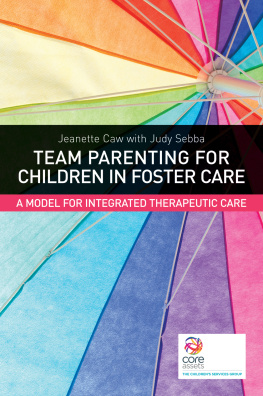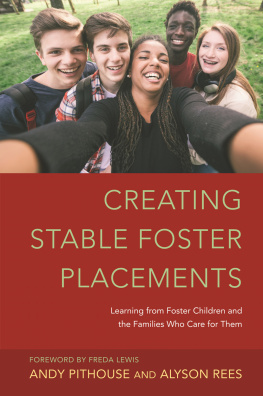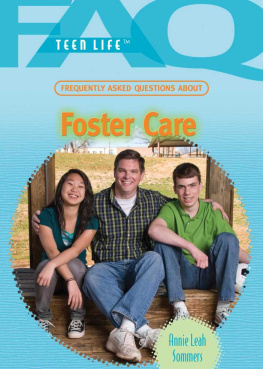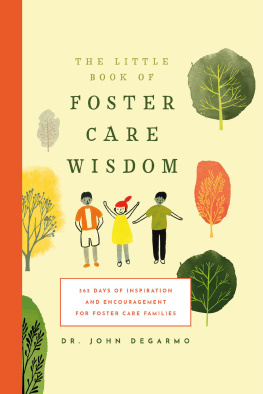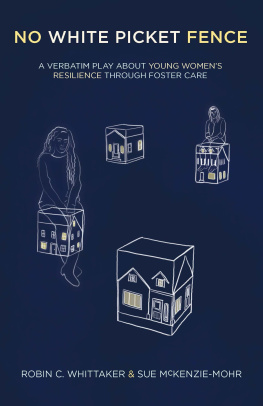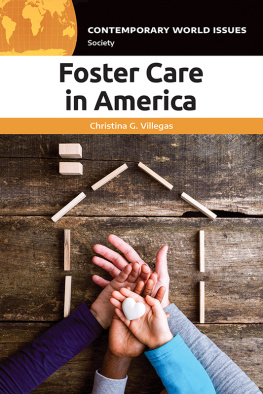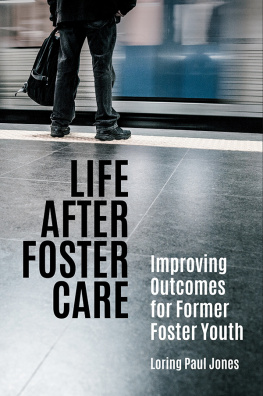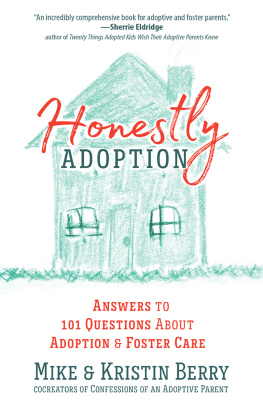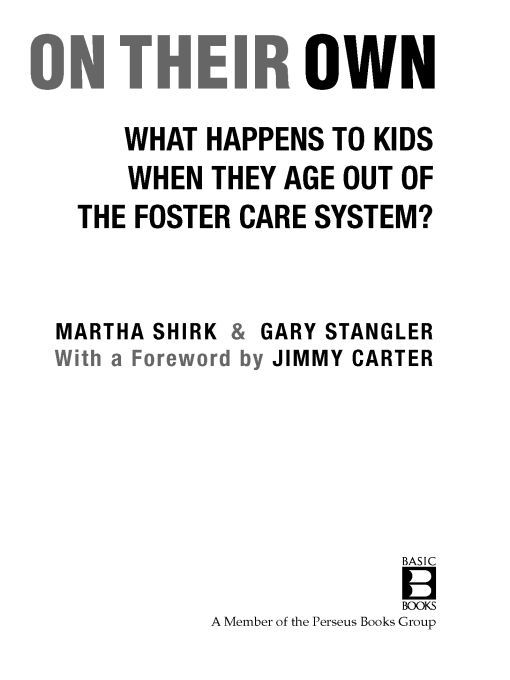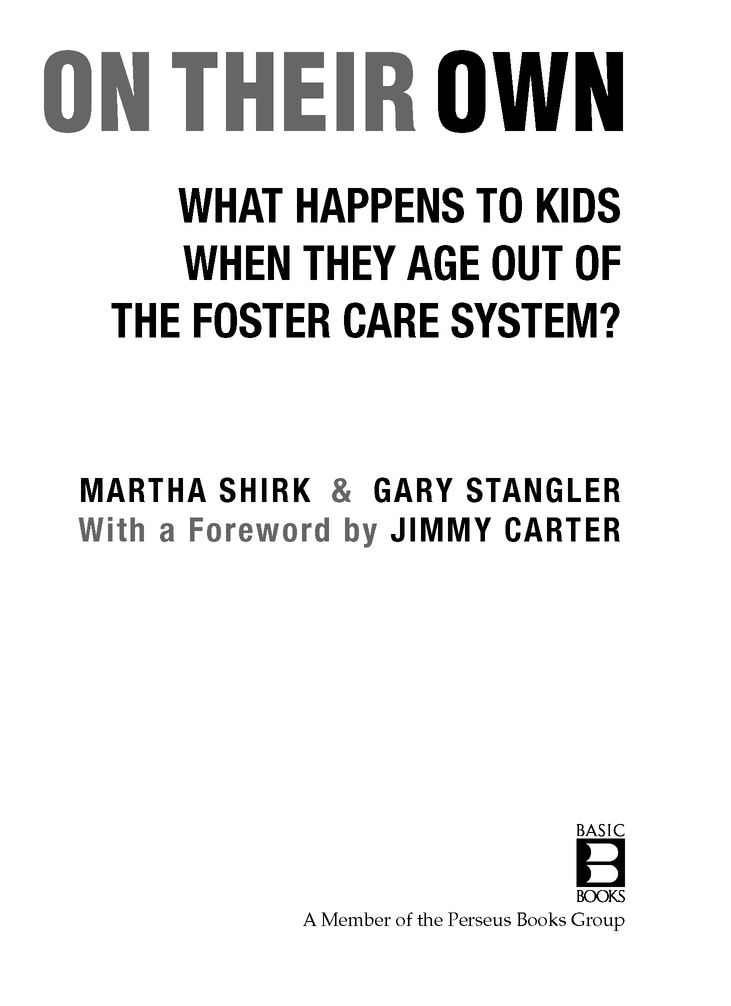Table of Contents
FOREWORD
by Jimmy Carter
In our travels around the globe, Rosalynn and I have seen the debilitating effects of poverty on some of the worlds most vulnerable populations. Our hearts have been wrenched by the faces of the many children and youth who have been marginalized and left to a life of want.
Unfortunately, these images are not confined to the developing world. Here in the United States, amid the greatest wealth the world has ever known, too many young people are trapped by poverty, by lack of education and opportunity, and by hopelessness. And as this book demonstrates in compelling detail, there is probably no group of young people in America more at risk than those who have aged out of foster care.
With the worlds biggest economy, billions of dollars a year of government spending on education and social services, and outstanding public schools and universities, Americans expect that our young people can all realize their dreams and become productive citizens. For most children who grow up in healthy, supportive families, little stands in the way. But for the half-million children and youth who inhabit our nations foster care system, the reality is more complicated, the future more in doubt.
Most of these children eventually return to their parents after they have overcome the problems that caused their children to be placed in foster care. Thousands more find love and support with new adoptive families. Still, every year as many as 25,000 young people reach the age of majority while still in foster care and abruptly lose the support of the state. In the words of Martha Shirk and Gary Stangler, they are on their own in a world for which they have been ill prepared.
In recent years, our newspapers have been filled with heartbreaking stories of young children who have been poorly served by our nations foster care system. But rarely have we been asked to reflect on the special challenges that older youth face as they prepare to leave a system that has fed and housed them and seen to their medical and educational needs. In most states, when these children turn eighteen, social workers close their cases. The assumption is that they are ready to be independent. But once they are emancipated from the system, many seem simply to melt away into societys cracks.
Recent polls indicate that a majority of Americans believe that most people dont achieve full-fledged adulthood until age twenty-six. Our own experience as parents bears this out. How many times do our own children, well past the age of eighteen, seek us out for advice, for money, or for a soothing word? What kind of a message do we send, as a society, if emancipation from foster care means no second chances, no room to learn from mistakes, no helping hand?
The reality is that young people who leave foster care at age eighteen are no more ready to become independent than our own children. In fact, most are probably less ready. Many youth in foster care do not benefit from normal growing-up experiences, such as holding down a part-time job, watching a parent balance a checkbook, or learning the meaning of household responsibility by performing daily chores. Without basic life skills, youth who leave foster care often have difficulty negotiating more complex tasks like finding safe housing, getting and keeping a steady job, staying healthy, and avoiding financial or legal trouble. Too few undertake the education and training necessary to compete in todays economy. In fact, four years after leaving care, only one in five former foster youth is fully self-supporting.
Our government has not been deaf to the needs of these young people. In 1999, Congress passed and President Clinton signed the Foster Care Independence Act, also called the Chafee Act, which expanded transition services for older youth leaving foster care. Although the new government mandates and funding are welcome, they are far from sufficient. Ensuring the safe passage of these young people into adulthood will take more creativity and cooperation than has been mustered so far.
In their arresting and important new book, On Their Own, Martha Shirk and Gary Stangler put a human face on this invisible population. On Their Own provides an intimate and often gripping account of the struggles and triumphs of young people at critical turning points in their lives. I was deeply moved by the experiences of those young people. Although I was troubled to read how bad decisions could so quickly lead them into crisis, I was also gratified to see that perseverance in the face of adversity usually paid off. And I was particularly pleased to see how the presence of a caring adult at the right moment could make a difference in their lives. In the end, these stories gave me hope.
On Their Own offers specific recommendations for how we can help youth leaving foster care become healthy, independent adults. Not content merely to describe the problems, Martha Shirk and Gary Stangler suggest improvements at the national, state, and local levels. Their observations cut across a number of policy domains, including workforce development, housing, education, health care, and personal and community engagement. They also point to the need for greater youth engagement in designing their road maps to independence and for greater cooperation among community organizations, child welfare agencies, charities, and business leaders in supporting them. Many individuals and groups are doing good work, but they have not worked closely enough with one another.
I commend coauthors Martha Shirk and Gary Stangler and the Jim Casey Youth Opportunities Initiative, which supported the creation of this book. The authors have created a vitally important addition to the literature on child welfare, foster care, and youth development. On Their Own is a must-read account not only for students of American social policy but for all Americans who care about children.
The question we should ask ourselves is this: If we willingly give our own children the benefit of our support as they struggle to become independent, productive adults, why do we tolerate the abrupt withdrawal of support for youth who are aging out of care? These young people go to the same schools, experience the same adolescent pressures, and yearn for the same successful futures as other youth in our communities. Their only crime was being born into homes where, because of abuse or neglect, they could not remain safe. Obviously, the state is no substitute for a caring family. But in the absence of family support, we as a nation must do better for children whose custody we have assumed.
I have long believed that how we treat the most vulnerable members in our society is a measure of the greatness of our nation. On Their Own makes clear that the current system leaves young people aging out of care with few educational and job resources, and with a lack of life skills and practical experience. Without support from caring individuals, many of these youth are making unwise and unhealthy decisions today that will affect them for years, if not the rest of their lives.
We should dream of and plan for a day when fewer children require foster care. But until that day comes, we have a moral responsibility to prepare young people leaving foster care for their journey into adulthood. Our communities must commit themselves to a common goal of helping these young people to become whole adults who can fulfill their potential and build bright and promising futures.


